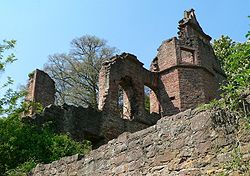Collenberg
| Collenberg | ||
|---|---|---|

Ruins of the Collenburg.
|
||
|
||
| Coordinates: 49°46′N 09°20′E / 49.767°N 9.333°ECoordinates: 49°46′N 09°20′E / 49.767°N 9.333°E | ||
| Country | Germany | |
| State | Bavaria | |
| Admin. region | Lower Franconia | |
| District | Miltenberg | |
| Government | ||
| • Mayor | Karl Josef Ullrich (CSU) | |
| Area | ||
| • Total | 23.85 km2 (9.21 sq mi) | |
| Population (2015-12-31) | ||
| • Total | 2,470 | |
| • Density | 100/km2 (270/sq mi) | |
| Time zone | CET/CEST (UTC+1/+2) | |
| Postal codes | 97896, 97903 | |
| Dialling codes | 09376 (Kirschfurt: 09375) | |
| Vehicle registration | MIL | |
| Website | www.collenberg-main.de | |
Collenberg is a community in the Miltenberg district in the Regierungsbezirk of Lower Franconia (Unterfranken) in Bavaria, Germany. It has a population of about 2,400.
Collenberg lies on right bank of the Main, 13 km away from Miltenberg and 18 km from Wertheim. Along the Main between Collenberg and Freudenberg runs the boundary between Bavaria and Baden-Württemberg. Behind Collenberg lie the wooded hills of the Spessart.
Collenberg’s Ortsteile are Fechenbach, Reistenhausen and Kirschfurt.
The community came into being in 1971 in the framework of municipal reform in Bavaria with the merger of the former communities of Fechenbach, Kirschfurt and Reistenhausen.
The council is made up of 14 council members, with the seats apportioned thus:
The community’s arms might be described thus: A fess wavy argent, in chief gules, dexter a wheel spoked of six and sinister a dog’s head erased gorged sable with studs of the first, in base azure three maces, two and one, issuant palewise from the base.
The three maces come from the arms once borne by the Schenken of Klingenberg, former overlords who gave the castle its name after the founder of their line, whose name was Kolbo (and in German, the word for “mace” is Streitkolbe, or simply Kolbe), and are thus a canting charge. The wheel in the escutcheon’s upper half on the dexter (armsbearer’s right, viewer’s left) side is the Wheel of Mainz, and refers to the area’s long rule by Electoral Mainz, lasting until the Holy Roman Empire was at last dissolved in 1803. The dog’s head on the sinister (armsbearer’s left, viewer’s right) side is another canting charge. Although the usual word for “dog” in German is Hund, there is also the word Rüde, and thus this dog’s head refers to the noble family of Rüdt von Collenberg. The wavy fesse symbolizes the local river, the Main.
...
Wikipedia



